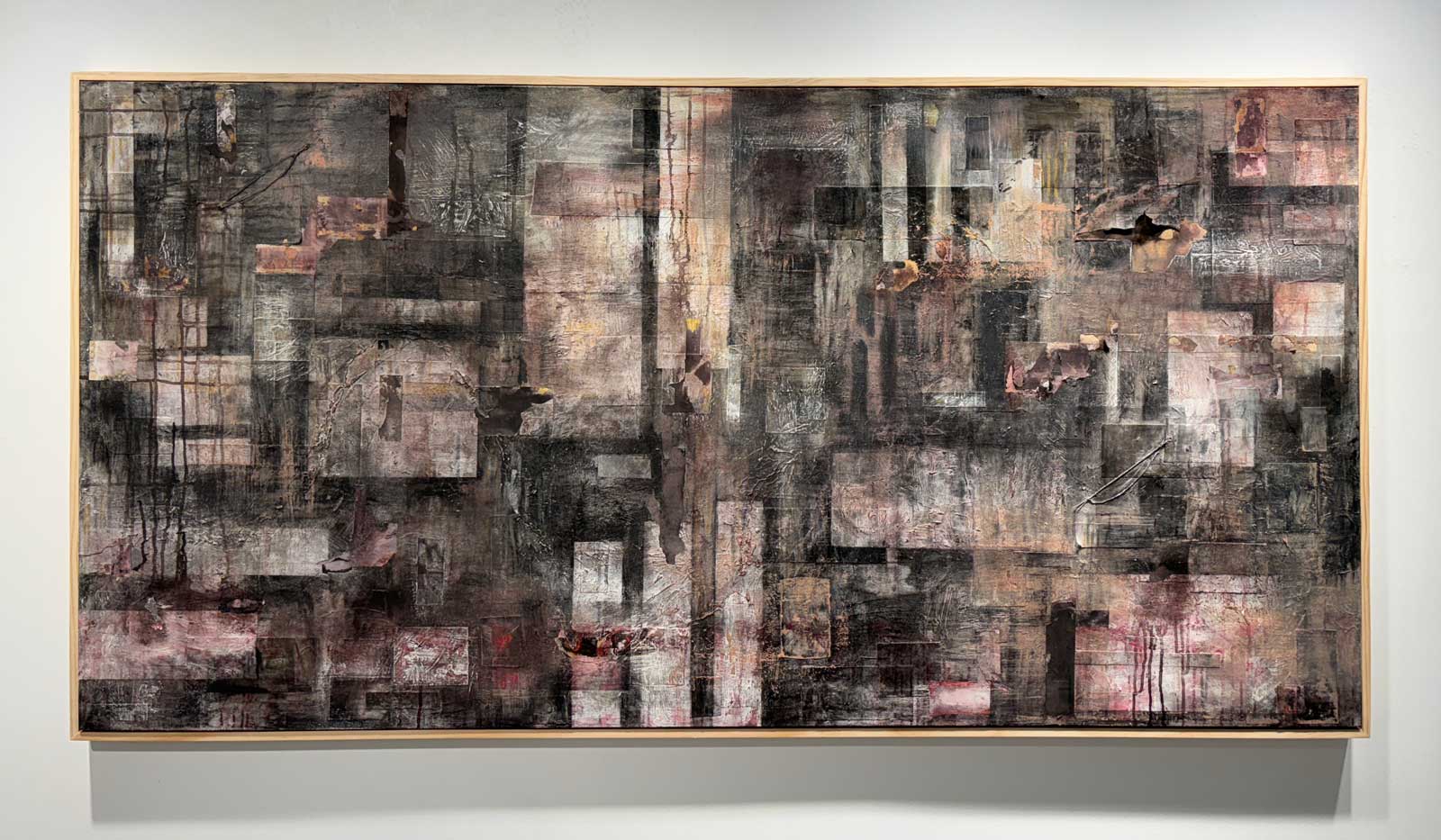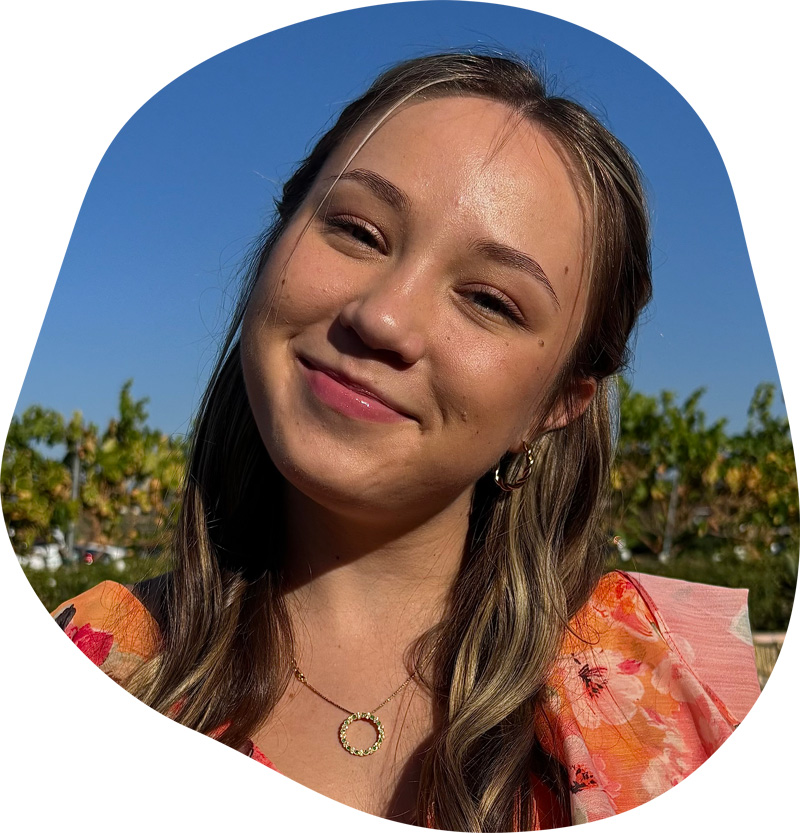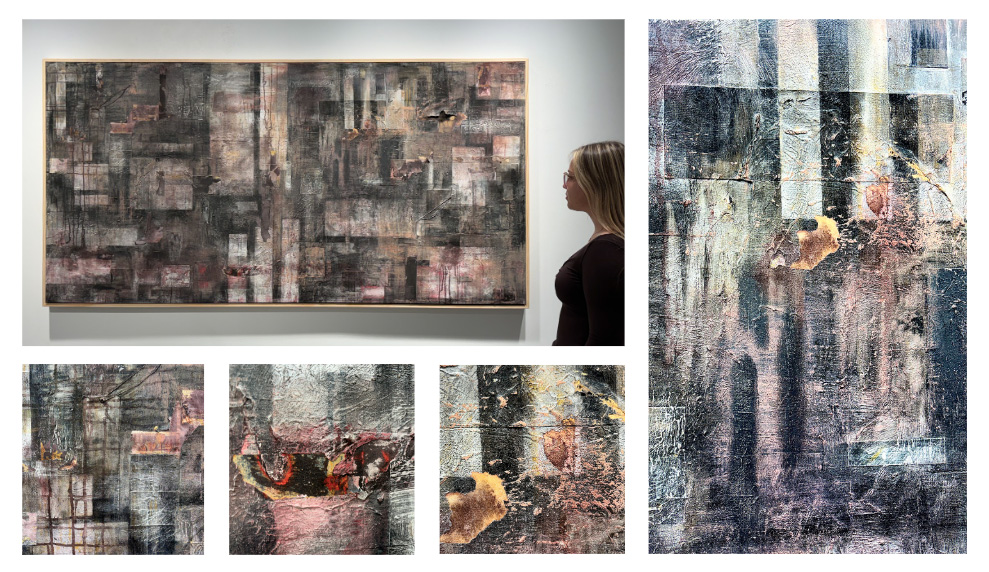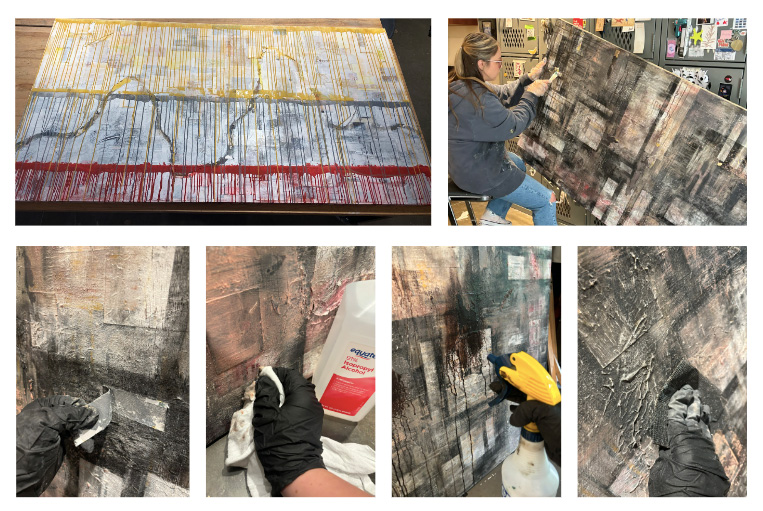

Give and Take

Height: 36" x Width: 72" x Depth: 2 " | Material(s): Collage under painting peeled away, acrylic wash to establish tone, charcoal for contrast | Process(es): Collage, peeling, scraping, chemical & physical removal (acetone), sanding, acrylic paint sprayed w/ water | Idea(s): Overwhelming add & sub mark show the quantity, time, & chaos of managing an illness thru collected data | Curatorial Note: Great manipulation and layering of the surface of the artwork as an analogy to the constant maintenance needs in diabetes management.
Makenna Ford


Student statement
Student statement
Please describe the context for how the idea for this artwork originated (was this part of your sustained investigation, an independent project, a class assignment, created during a summer study, etc.).
This work was part of my sustained investigation during my senior year, exploring the relationship between control and irregularity in the ongoing management of my Type I Diabetes. My body of work originated with printmaking. I found the printing process similar to the process of regulating my condition, as the procedure is fixed but the individual outcomes vary. I aimed to depict the relationship between inconsistency and permanence within daily management through prints that correlated with my glucose levels. As I continued experimenting, I found that collage displayed evidence of time more tactilely through layering and stacking. Diabetes is a tedious and unchanging condition, so I explored the “give and take” nature through additive and subtractive processes to convey this tangibly. I used my previous prints as collage material along with packaging from my medical devices, medical records, and other found materials.
In what ways did you practice and experiment when developing your sustained investigation?
Experimenting with several forms of printmaking, I found it offered permanence in media and unreliability in results, mirroring my inquiry of control vs irregularity. I became interested in continuous alteration, my work serving as a log of my medical management through constant revision and becoming a time based practice. As I shifted from printing to collage, I focused more on how my use of media reflected my diabetes management rather than logging the details my condition. In this piece, I used additive and subtractive processes including collage, chemical alteration, painting, taping, and peeling away material to reflect the give and take of perpetual management.

Utilizing my medical data, I depict the relationship between inconsistency and permanence within daily management.

Material(s): Collage under painting peeled away, acrylic wash to establish tone, charcoal for contrast. | Process(es): Overwhelming add & sub mark reflect the quantity, time, & chaos of managing an uncontrollable illness
Your work was selected in part because it achieved synthesis. Can you explain your intentionality in choosing materials and developing processes to further your ideas?
My idea was furthered by the relationship between my media and my idea. Regulation and management of a chronic condition requires constant attention to detail, ability to adapt, and experimenting with different methods- all of which I did within my work to achieve synthesis.
How did your art teacher support your artistic development?
Mr. Mac was my teacher all four years of high school, but he taught me so much more than just artistic practices. Mac was my biggest mentor and felt far more like a parent or friend than just my teacher. He pushes all his students to have excellent craftsmanship, personal voice, technical skill, and commitment to their craft. He said once that “the best artwork is selfish” but Mac is the most selfless person I know and sacrifices so much to see his students thrive and succeed. I would have nowhere near the artistic knowledge, integrity, or love for art that I do today if not for him.
What is your advice to other AP Art and Design students?
You can make beautiful work but to truly succeed you have to have confidence in your own skill set and ideas. Feedback and critique from other artists is crucial but time, practice, and self assurance are what really set your work apart!

Material(s): Alcohol as subtractive mark on charcoal, collage peeled to show concealed previous layers, water | Process(es): Revision of pre-painted canvas by peeling,scraping, w/alcohol; chemical & physical removal, sanding
Brice McCasland
Lovejoy ISD K-12 Visual Art Coordinator
Lovejoy High School, Lucas, TX, USA
Teacher statement
Teacher statement
The AP Art and Design course supports inquiry-based personalized learning in the sustained investigation portfolio component. What strategies helped you guide students through inquiry?
One of the greatest strategies that I know of to encourage students on the journey of a sustained investigation is a community of trust, responsibility, and commitment among their peers. While there are many formal and informal strategies to help guide an artist's inquiry; the agency, accountability, and collaboration that come from a strong cohort of artistic peers is unmatched.
How did you scaffold writing into the artmaking and thinking processes?
In our studio, we utilize writing for every work. Students create “mock-ups” for each piece (both AP and Non-AP courses) where they utilize writing, images, sketches, and other planning and practice to create structure and direction around their thinking. As artists begin their sustained investigation they utilize this same structure to think through their inquiry through both written and visual evidence. With each new work, students edit and modify their inquiry statements and questions so that the language and descriptors they are using to describe their work is driven by the idea that it is guiding all of their work. This writing and thinking is also used for the presentation and critique of each completed work and the plan for the next piece. This allows peers to offer feedback on the correlation between what they see in the work and how the artist is describing it.
How did you support skill development AND inquiry in the AP Art and Design curriculum?
Our studio sees the relationship between skill development and inquiry as working hand in hand. While all of our artists spend the first 12 weeks of school developing their skills and language with a variety of media and approaches, the best skill development is guided by the practice and experimentation that the sustained investigation calls for. Focusing on their idea and personal voice allows our artists to direct their practice and technical skills with different media based on what the idea calls for. We believe that allowing your inquiry to guide your media and process gives intention and purpose to both the application and the development of your personal language.
How did you structure practice, experimentation, and revision into your AP Art and Design curriculum?
We believe deeply in the power of P.E.R. to transform our work! As a K-12 program, we focus on the importance of practice/process and experimentation as a catalyst for informed decision-making. Students in every studio course utilize practice before beginning work on their final idea/work. This practice of exploration and experimentation before planning and pursuing an idea creates confidence in the creative process that is irreplaceable. Students in AP Studio Art and Design employ the idea that all good work is built on the back of P.E.R. in every piece they take on. After we critique each work, artists are given 1 week to reconsider and revise their work based on the feedback that they received from their cohort. During this 1 week timeframe, artists are also working on their next piece. By overlapping their revision and the planning for their next work, there is a rich sense of discovery and development intertwining their investigation and the media/ processes they are using in each work.
How do you support your students in the Selected Works portfolio component?
The picking of each artist's Selected Works is one of my favorite days! It is always so hard to choose which works will make the cut! A week before we submit our portfolios we hold a group critique where each artist can present up to 10 physical works to gain group feedback and insight around what their strongest pieces are. Everyone utilizes the SW Rubric and language to score the proposed works and offer clear feedback around each piece. The perspective and input from the studio cohort offers each artist insight into their personal voice and how they are answering design/drawing issues in their work that allows them to reflect and choose the 5 works that best represent their personal ideas and artistic language.
What formative and summative assessments helped guide your students through your AP Art and Design curriculum?
Artists in our AP Studio Art and Design courses utilize rubrics for each work that they create throughout the year. Whether these works are aimed toward their inquiry or the idea of practice and experimentation in preparation for their sustained investigation, the rubrics utilize a 1-5 scoring system that uses the same language and vocabulary as the AP Art and Design glossary and SI/SW Rubrics. As students develop their inquiry, we use a rubric built to mirror the AP Studio SI Rubric; ensuring that we are scoring the sustained investigation using the same descriptors and practice as AP Readers. Each artist is asked to use a modified version of the AP SI Rubric to score their own work, and then score each other's work as part of our critique practice. Using the AP SI Rubric and glossary allows students to offer informed and objective feedback about each work and the idea guiding it. As students work through their sustained investigation; we critique and score the WHOLE BODY of work just as it will be scored at the reading. This allows students clarity on how their portfolio will be scored and provides them with clear and effective information on how to reach the next score point. Additionally, students receive credit for critique participation (written feedback through the rubric and verbal feedback as a part of the cohort) and planning for each work.
What creative programming (i.e., exhibit spaces, mentoring programs, curricular supports) have you implemented to support AP Art and Design students?
As a public school, we are very thankful to have a gallery space in our high school that is managed by student leaders from AP Studio. This gallery space has been transformative to the culture, advocacy, and support of our K-12 artists. While we try to show work from all of our courses everywhere that we can our gallery has created a platform for our community to participate in the vital role the creative process plays in our students' lives. What makes this space even more impactful is the fact that it is managed by a team of our student leaders. The ownership, agency, and sense of community that this built around our program’s care and celebration of artists' ideas and work at every level is unlike anything I have ever experienced. Additionally, the legacy and leadership of our studio are rooted in the act of mentorship. In our studio, all Seniors who have taken an AP Studio course mentor 1 or more underclassmen. As mentors, our seniors serve as a first line of compositional advice, media feedback, and a voice of encouragement for our underclassmen in AP studio that is irreplaceable. The ownership and responsibility that our seniors take on as mentors are the lifeblood of our program and its legacy.
What did you learn from working with your student?
Working alongside Makenna is like walking into a ray of sunshine. The brilliance is both palpable and refreshing. While I feel like I learned too many things from Ms. Ford to fit into a neat paragraph, the biggest things that I learned from Makenna are much larger than art or any portfolio. Makenna is one of the most natural leaders I have ever met. She is as driven as she is kind, she is as gracious as she is strong, she is as flexible as she is resolute. When our mentors talk about how they hope to lead, it is always Makenna that is mentioned. The same authenticity and commitment that Ms. Ford shows to everyone around her lives at the core of her work. Her work speaks to her tireless patience, thoughtful attention, and rich intelligence. Anyone who knows Makenna would agree that she inspires you to be your personal best, to be giving, humble, and selfless in leadership and service to others.
Makenna Ford

